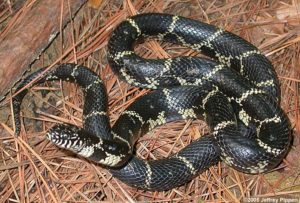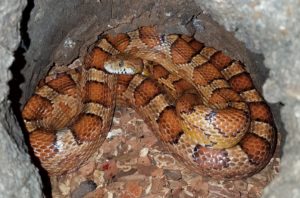What’s the first thing that comes to mind when you hear the word snake? Scary? Slimy? Spooky? Sure, snakes don’t always look as friendly as other wildlife, and certainly there are some species that you don’t want to get close to, but the truth is, snakes really aren’t all that bad once you get to know them!
If you’ve seen more snakes than usual lately, it’s because they are most active during the spring and summer. We know snake sightings can cause some fear and concern though, so we spoke with Park and Rec’s Kristen Haas to learn more about the snakes that call Mecklenburg County home. Today, we explain what you need to know.
Types of Snakes in the Charlotte-Mecklenburg Area

Our resident eastern kingsnake!
There are at least 22 non-venomous species of snakes in Charlotte-Mecklenburg, such as the worm snake, scarlet snake, black racer, ring-necked snake, and black rat snake (to name a few). One species in particular that is good to have around is the eastern kingsnake. Why? Because it eats venomous snakes!
Out of the many local snakes we have, only TWO are venomous: the copperhead and the timber rattlesnake (more on these below). Copperheads are the more common of the two, but it’s important to still be aware of both.
Learn more about the reptiles and amphibians in our state here.
How to Identify Venomous Snakes
The easiest way to distinguish venomous snakes from non-venomous snakes is by their physical characteristics. The distinct characteristics of a copperhead are:
- They have a triangle-shaped head. This results from their big cheeks, which is where their venom sacs are.
- Their pattern is wide on the side of their body and gets skinnier as it goes up and over the top (comparable to a Hershey Kiss).
- They have long and narrow pupils like cats.
- Juvenile copperheads have bright green tail tips that they use to lure smaller prey.

Our resident corn snake! Note the skinnier head and distinct pattern on its back.
IMPORTANT! Copperheads are often confused with the non-venomous corn snake. While they may be similar in color (though not always – corn snakes can be brown, red, orange or black too), corn snakes are skinnier with more slender cheeks and have more of a pattern on their backs compared to copperheads who have it on their sides.
The distinct characteristics of timber rattlesnakes are:
- A rattle on the tail.
- A triangle-shaped head (remember: wider towards the bottom means venomous).
- An arrow/chevron pattern on their back.
BONUS TIP: If you come across any black, mostly black, or solid colored snake, it is NON-VENOMOUS!
Tips for Dealing with Snakes Near Your Home
If you’re seeing snakes near your home, it’s because you have what they need: food, warmth and a place to stay safe. Snakes like areas that are dark and not often disturbed, so they gravitate toward places like the space under sheds and decks, wood piles, tall grassy/wooded areas, and dark corners of garages. You may also be seeing more if you have a rodent problem in your yard since rodents are a source of food. Should you come across a snake that is too close for comfort, here’s what you can do:
- Non-venomous snake: Wearing closed-toed shoes and some form of hand protection (like thick gardening gloves), take a long stick or trash grabber if you have one and coax the snake away from your home. If it’s small enough, you can guide it into a bucket or trash can with a lid so that you can safely move it.
- Venomous snake: While you can relocate venomous snakes in a similar manner, you should not attempt to catch or move one without the proper equipment and know-how. Your best bet in this case is to call a professional company or simply leave it alone.
Chances are, the snakes that you’re seeing are just passing through and will be gone from your home in no time. And although they may not look that friendly, know this: they are not going to bother you unless they feel bothered! They are just trying to survive and thrive like all other living things and start to bite if they feel threatened.
If you’d like to learn more about snakes, we invite you to come to one of our three nature centers! We have incredibly knowledgeable staff that can expand on the topic of snakes for you, plus you can even meet some of our resident snakes. You can also send a picture of any critters you find to Park and Rec staff through Facebook – they’d be happy to identify them for you!
